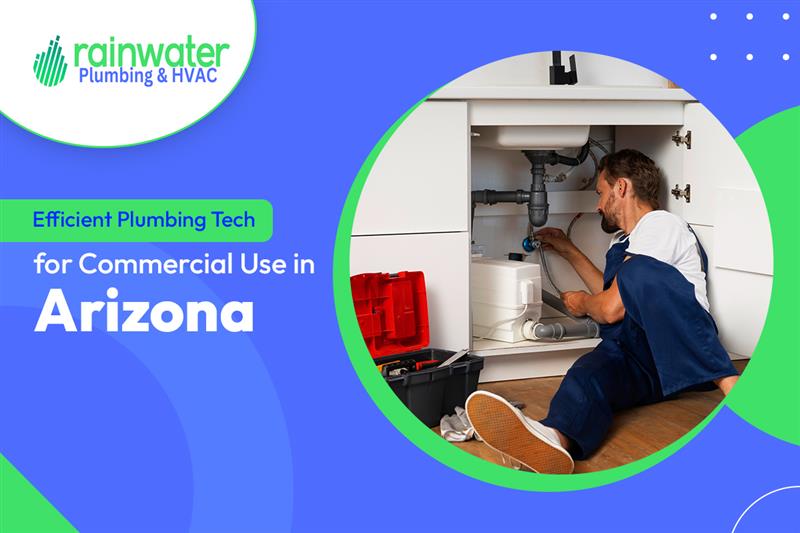Arizona is the most water-stressed state in the US due to droughts, climate change, and overconsumption. Therefore, commercial buildings must enhance their water consumption efficiency and adopt solutions for water conservation efforts. Fortunately, plumbing technology has progressed over the past few years to reduce water usage, improve environmental sustainability, and lower operating costs. Additionally, commercial enterprises need to choose the right partner for upgrading their plumbing infrastructure.
Top Plumbing Technologies for Efficiency
Smart Leak Detection Systems
Smart leak detection systems are advanced plumbing technologies that detect a leak within the system without any human intervention. They are more often used in commercial buildings because the plumbing structure is more complex. The common features of a smart leak detection system are as follows:- Sensors: Smart Detection systems operate based on a network of sensors for detecting leaks. These sensors are strategically placed to detect water or any other liquid. The sensors are built on the foundation of moisture detection, flow monitoring, and pressure sensing.
- Connectivity: Smart leak detection systems connect to a central system or the user’s computer and smartphone via wireless connections. The mediums can vary, including Bluetooth, Wi-Fi, cellular networks, and more.
- Real-time Alerts: The sensors detect leaks and send alerts to the user’s phone or computer through text messages, notifications, or emails. The data alert is given out in real-time so that immediate action can be taken.
- Automatic shut-down: The advanced version of the technology can shut down the plumbing system if the leak is serious enough. This prevents significant water loss.
- Data logging and analysis: The smart leak detection system records and analyses the data on the condition of the plumbing system. AI technology can also predict the potential vulnerability of the plumbing system.
Touchless Fixtures and Sensor Faucets
Touchless fixtures are the new technology implemented in commercial buildings for water conservation and hygiene enhancement. The fixtures and faucets eliminate the need to be touched and thus protect the user from bacteria and other pathogens. They also provide water when needed and thus conserve water. Some of the key aspects are as follows:- Motion detection: This technology is based on motion detection that uses an infrared sensor to detect human presence before letting off water. They are powered by electrical connections and a battery and can be adjusted for water duration and sensitivity.
- Flexible designing: Touchless Fixtures and faucets come with various designs and textures to fit the aesthetics of the room. Thus, they are suitable for residential and commercial use buildings.
- Installation: These faucets can be installed in construction buildings and in already finished plumbing systems. Some models come with DIY installation, while others need professional help.
- Maintenance: They are made to be durable, but can require maintenance from time to time. For instance, the sensors and batteries need to be checked regularly.
Tankless Water Heaters
Tankless water heaters are heaters that heat water as it passes through the heater without any storage facility. They are installed at the point of use to get hot water whenever needed. Some of the features are as follows:- Energy-efficient: Tankless water heaters have a far better ability to save water and energy than centralized heaters. They are used at the point of use and heat water instantly without storing it.
- On-demand heating: The water is heated on demand with no waiting time. Tankless water heaters can access water directly from the storage facilities without any intermediaries.
- Space-saving design: The tankless water heaters save space as they do not have extra storage space. They are tight and well-mounted and appropriate for the commercial spaces that are facing a crunch.
- Customizable Temperature Settings: Tankless water heaters have options to customize the temperature. This provides control to the user to get the desired temperature.
- Potential for Retrofitting: Tankless water heaters have flexible designs and can be retrofitted into existing homes. However, some models may require upgrading the current gas and electric lines.
Greywater Recycling Systems
Greywater recycling systems are recycling systems that collect water from showers and basins and send the water back to the house after purifying the flow. These systems can reduce the pressure on the municipal water supply.- Treatment Processes: These systems have different stages of purifying and treating grey water from the house. They use filtration, sedimentation, biological treatment processes, and disinfection to remove contaminants from the water.
- Filtration: Greywater recycling systems have a filtration system within themselves. It removes debris, dirt, harmful pathogens, and toxic chemicals from the water flow.
- Disinfection: Some systems use ultraviolet light to kill harmful materials and pathogens. Such a process is also called ozonating.
- Automated Control Systems: This system is ingrained within the recycling machine for monitoring and scanning for the water condition before it is sent back to the house.
How These Technologies Benefit Arizona Businesses
- Water conservation: These technologies will conserve water for commercial buildings in Arizona and reduce water scarcity. Contactless fixtures and recycling pumps will contribute to this objective.
- Cost savings: Water savings will result in lower utility bills for businesses and reduce operating costs for commercial buildings. Leak detection technologies can prevent costly damage and leakages before they get out of hand.
- Hygiene: The new plumbing techs are useful for maintaining hygiene, while tankless water heaters save water consumption. It prevents contamination from one person to another.
- Energy Efficiency: A tankless water heater also helps in energy efficiency, only dispensing water when it is needed.

